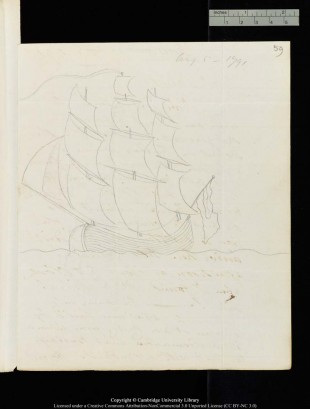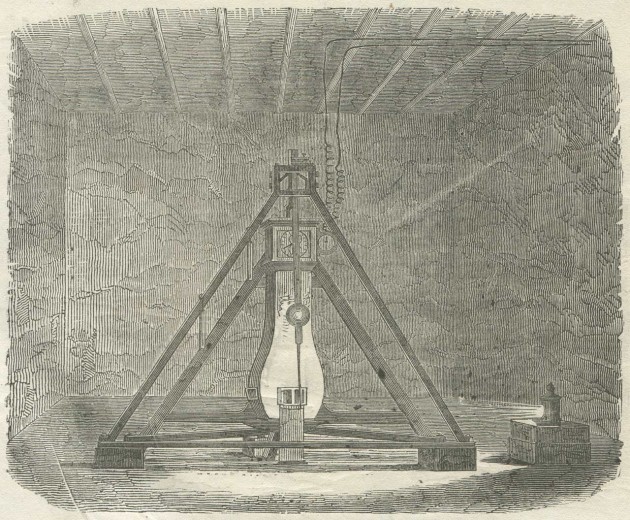…where east meets west
- Home
- Brief History
- The Greenwich Meridian
- Greenwich
(1675–1958) - Herstmonceux
(1948–1990) - Cambridge
(1990–1998) - Outstations (1822–1971)…
- – Chingford (1822–1924)
- – Deal
(1864–1927) - – Abinger
(1923–1957) - – Bristol & Bradford on Avon
(1939–1948) - – Bath
(1939–1949) - – Hartland
(1955–1967) - – Cape of Good Hope
(1959–1971)
- Administration…
- – Funding
- – Governance
- – Inventories
- – Pay
- – Regulations
- – Royal Warrants
- Contemporary Accounts
- People
- Publications
- Science
- Technology
- Telescopes
- Chronometers
- Clocks & Time
- Board of Longitude
- Libraries & Archives
- Visit
- Search
Astronomical Regulator: Earnshaw
page under construction

H.M.S. Deadalus. Drawing by William Gooch, 5 August 1791. Reproduced under the terms of a Creative Commons Attribution-Non-Commercial (CC BY-NC) licence courtesy of Cambridge Digital Library (see below)
Originally bought by the Board of Longitude in 1791, it was sent with the astronomer William Gooch on H.M.S. Daedalus for transfer to H.M.S. Discovery (which was under the command of George Vancouver) where it was used during the mapping of the coast of north-west America. It was later used by Matthew Flinders to map Austrailia during his circumnavigation on the H.M.S Investigator.
On the Board of Longitude’s demise in 1828, the clock was seemingly transferred to the Royal Observatory. Whilst in the Observatory’s care, it was used with Pond’s Great Zenith Tube and then the Sheepshanks Equatorial. It was also sent to Harton Colliery in 1854, where Airy used it to re-determine the weight of the Earth. Twenty years later, in 1874, it was sent on the Transit of Venus expedition to Hawaii. Deemed surplus to requirements, it was sold (along with Arnold 2) to Messrs Clowes & Jauncey in 1938. Puchased by Mark Dinley it remained in his family in England until 1994 when it was sold to the Museum of Applied Arts & Sciences, Australia, where it remains today (Object No. 94/15/1).
The clock is believed to have been wall mounted whilst at the Observatory and was fitted with a zinc and steel pendulum for the 1874 Transit of Venus. It is now fitted with a replica gridiron pendulum (fitted after its sale to Clowes & Jauncey). The case is believed to have been extended at some point to make the regulator floor mountable.

The regulator Earnshaw on 24 November 1854 during a lecture given by Airy to the Mechanic's Institution and Working Men's Institution of South Shields shortly after his experiment to measure the weight of the Earth in the shaft of Harton Colliery had been completed. The clock is mounted on a cast iron tripod on which a Kater pendulum was also mounted (this can be seen swinging in front of it). From the 4 November 1854 edition of The Illustrated London News
Some Key dates in the regulator’s history
| 1791 | 5 March: The regulator heads the list of ‘Instruments proper to be sent with the Astronomer going to the North West coast of America’. In the list, it is described simply as ‘An astronomical clock’ (RGO14/13/153). In a second list dated 2 July (RGO1413/155), it is described as 'An Astronomical Clock by Earnshaw' |
||
| 1791 | August: Gooch sets sail on the H.M.S. Daedalus with the instruments contained in the list above. | ||
| 1792 | 12 May: Gooch killed in Waimea on Oahu. | ||
| 1792 | August: H.M.S. Daedalus rendezvous with H.M.S. Discovery. | ||
| 1795 | 20 October: H.M.S. Discovery returns to the UK. |
||
| ... ... |
... | ||
| 1824 | The 1824 inventory (RS MS 371/70) records ‘Clock Earnshaw’ in the Calculating Room (which in the earlier inventories was referred to as the Middle Room) |
||
| 1828 | 15 July: Board of Longitude dissolved by Act of Parliament. An undated (rough?) inventory (RGO6/54/9) seemingly from the second part of the 1820s appears to record ‘A Cock by Earnsh aw’ as being present in the Calculating Room (which in other contemporary inventories is described as the Middle Room) |
||
| 1830 | The 1830 inventory (RS MS 371/71) records ‘A Clock by Earnshaw’ in the Calculating Room. An undated (rough?) inventory (RGO6/54/9) seemingly from the second part of the 1820s also records ‘A Cock by Earnsh aw’ being present in the Calculating Room. |
||
| 1831 | Earnshaw does not appear to be listed in the inventory for 1831 (RGO6/54/38), but the 1831 inventory does however include a number of objects formerly belonging to the Board of Longitude that were brought to the Observatory on 11 June 1829. | ||
| 1834 | Recorded as being added to the inventory in the minutes of the Annual Visitation by the Board of Visitors in 1834. Recorded as ‘A Sidereal clock by Earnshaw’ (ADM190/4/76) | ||
| 1836 | ‘Near the bottom of the Zenith Tube’ (1836 volume of Greenwich Observations). | ||
| 1838 | Not mentioned in Greenwich Observations. Assumed to still be with the Zenith Tube – The Sheepshanks Equatorial came into use this year, but Observations made with it of Encke’s Comet between 29 October and 13 November were done using Chronometer Brockbanks rather than a regulator. (Observations of Encke’s Comet, from Greenwich Observations). | ||
| 1839 | In South Dome with Sheepshanks Equatorial (1839 volume of Greenwich Observations), where it was used during observations of Galle’s First Comet. |
||
| 1840 |
Inventory of 15 May 1840 (RGO6/54/89). Listed in the East Dome (formerly known as the South Dome and later as the Sheepshanks Dome) with the Sheepshanks Equatorial. |
||
| Item 24: ‘A clock by Earnshaw with gridiron pendulum (formerly in the Zenith Sector Apartment) adjusted to sidereal time’. This appears to be the earliest reference to the type of pendulum that was fitted. |
|||
| Item 25: ‘A winder, and lamp-bracket, for the clock’. | |||
| Duplicate record in RGO39/1/17&18. | |||
| 1854 | Sent to Harton Colliery where it was used with Kater’s pendulums in an attempt to determine the mass of the Earth. Transported to Newcastle on the Denmark on 23 September, returning on 31 October (RGO6/25). Click here to read the account. |
||
| 1855/6 | Installed in laundry room of Flamsteed House at end of 1855 (not before 12 November) and used between 1–12 January 1856 for further observations relating to the Harton Colliery experiment. Click here to read more. | ||
| 1874 | Sent to Kailua, Hawaii for use as a transit clock by the Transit of Venus expedition. The account of the observations states that ‘its former gridiron pendulum was replaced with one of Messrs. E. Dent and Co.’s cylindrical zinc and steel pendulums and it was otherwise put into good order by them. At Kalua it was mounted on a firm tripod pedestal of wood and iron, which stood upon pickets of 8-inch timber driven firmly into the ground, the floor of the observatory being cut away clear of them.’ | ||
| ... ... |
... | ||
| 1880 | Returned to the East Dome (Sheepshanks Dome) on 29 November where it replaced Dent 1915 (Greenwich Observations 1880). | ||
| 1909 | March 12: the zinc & steel pendulum removed and fitted onto Dent 2. Earnshaw refitted with its original gridiron pendulum (RGO7/44). | ||
| After | 1933 | Moved from Sheepshanks Dome to Upper Record Room on the floor below (1933 Inventory: RGO39/6/208). | |
| 1938 | Sold to Messrs Clowes & Jauncey in May (1933 Inventory: RGO39/6/208). |
||
| After | 1938 | Sold to Mark Dinley | |
| 1994 |
Sold to the Museum of Applied Arts & Sciences, Australia, where it remains today (Object No. 94/15/1). | ||
Image licensing information
The drawing of H.M.S. Daedalus is reproduced in compressed form under the terms of a Creative Commons Attribution-NonCommercial 3.0 Unported License courtesy of Cambridge Digital Library (Letters, memoranda and journal containing the history of Mr William Gooch (Mm.6.48/59).
© 2014 – 2025 Graham Dolan
Except where indicated, all text and images are the copyright of Graham Dolan